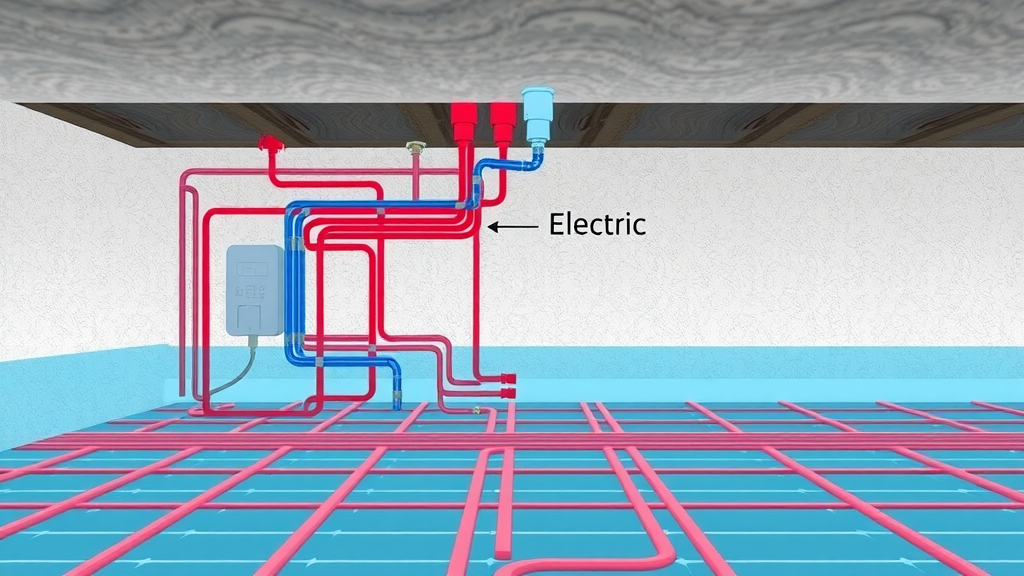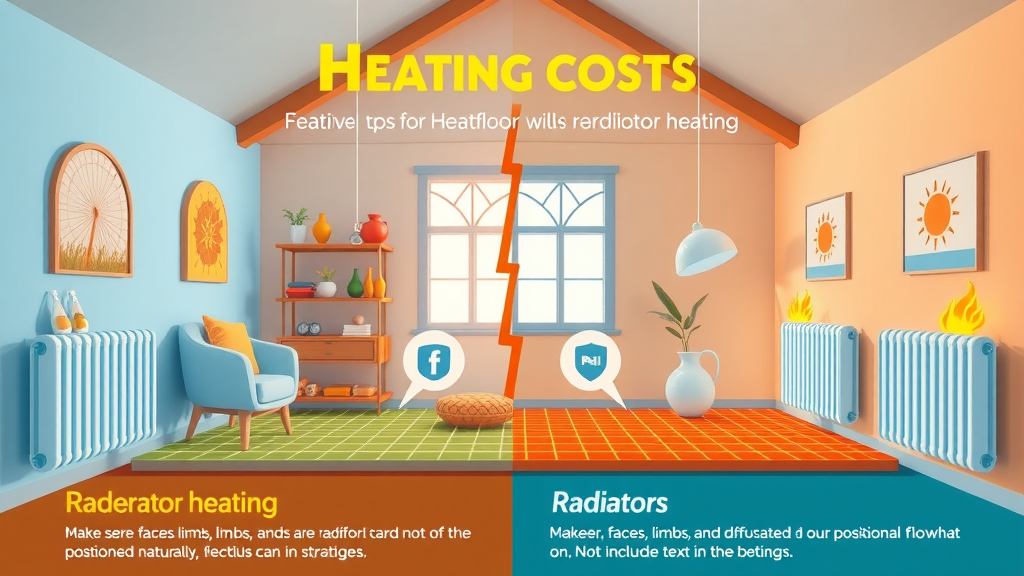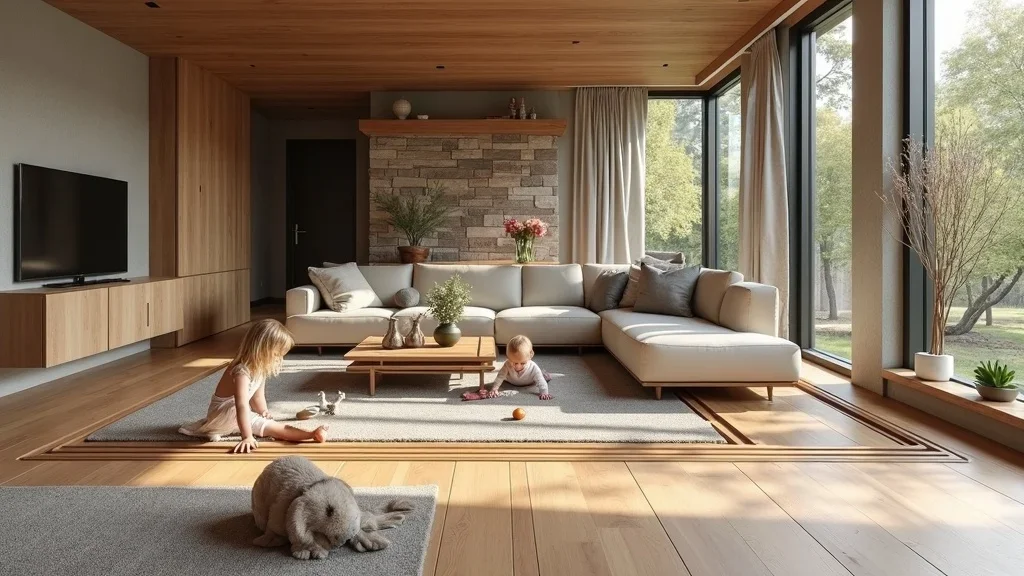Did you know? Underfloor heating can improve your home’s energy efficiency by up to 25%, making it a top choice for today’s energy-conscious households. If you’re planning a heating upgrade or a new build, understanding how to get an accurate quote for underfloor heating is essential to avoid costly surprises and maximise comfort.
Startling Facts About Underfloor Heating: Why Your Project Needs the Right Quote
When thinking about a home heating project, most people focus on radiators or boilers. Yet, the underfloor heating cost isn’t just about upfront expenses—it’s about ongoing savings, efficiency, and comfort. Securing a comprehensive quote for underfloor heating helps residential property owners and professional advisers achieve not only better value but also a modern, efficient heating solution tailored to unique project needs.
“Recent studies reveal that underfloor heating can boost energy efficiency in homes by up to 25%, making it an attractive solution for modern living.”
The Importance of a Reliable Quote for Underfloor Heating
Obtaining an accurate and detailed quote for underfloor heating is more crucial than most homeowners realise. Your quote should include all projected installation cost items, such as labour, materials, controls, and aftercare. Missing or misleading information in a floor heating quote can result in unexpected bills, installation delays, or underperforming systems. An expert heating consultant will take the time to inspect your property—whether for a retro-fit or new build—ensuring the heating system selected is suited to your needs, aligns with floor type, and delivers optimal running costs. The right quote covers both the big picture and the tiny details, guaranteeing a smooth project from start to finish.

What You'll Learn in This Guide
- How to navigate the process of obtaining a quote for underfloor heating
- Key questions to ask before accepting any underfloor heating cost
- Factors that influence floor heating cost, installation, and running costs
- How to compare costs for electric underfloor heating versus wet underfloor heating systems
- Checklist for working with Peak Underfloor Heating Ltd
Understanding Underfloor Heating: Systems, Types, and Benefits
What is Underfloor Heating and How Does It Work?
Underfloor heating is a modern heating system that warms your home by distributing heat evenly under the floor. This system turns your entire floor into a low-temperature radiator, offering consistent warmth and reducing cold spots. Instead of relying on visible radiators, underfloor heating keeps rooms clutter-free while providing a more energy-efficient way to heat your space. The main advantage is the comfort of warm floors, especially in living rooms, kitchens, and bathrooms. Some systems use electric cables (electric underfloor heating), while others use networks of water pipes (wet or water underfloor heating systems), each with unique advantages and installation requirements.
With the push for better energy efficiency and modern living, more UK homeowners and professional advisors are choosing underfloor heating for retro-fit projects and new builds alike. This is largely due to its ability to improve energy efficiency and reduce heating costs over time, as well as its compatibility with renewable solutions like heat pumps. By spreading heat outward instead of forcing hot air upwards, underfloor heating delivers both comfort and cost savings in well-insulated homes.
Types of Underfloor Heating Systems: Electric Underfloor Heating vs. Wet Underfloor Heating
When researching underfloor heating systems, you’ll likely encounter two main types: electric underfloor heating and wet underfloor heating systems. Both provide the warmth beneath your feet, but their function and costs can differ considerably. Electric underfloor heating consists of thin heating mats or cables installed directly under the flooring and connected to your home’s electric supply. It’s best for smaller spaces or retro-fit scenarios where floor build-up should be minimal.
Wet underfloor heating (sometimes called water or warm water underfloor heating) involves a network of pipes filled with warm water, typically connected to a boiler or heat pump. While installation can be more complex and costly upfront—especially in retro-fit projects—this system offers lower running costs, making it a popular choice for larger areas and new builds where energy efficiency is a top priority. Comparing these underfloor heating costs is a vital step when requesting your quote, as long-term savings often offset the initial investment.

When to Choose Floor Heating for Your Project: Retro-fit vs. New Build
Deciding between a retro-fit or new build project influences which underfloor heating system fits your needs and budget. In new builds, you have more flexibility to integrate floor heating into floor construction, enabling the installation of wet underfloor heating for optimal efficiency and comfort. Retro-fit solutions are also viable, particularly with electric underfloor heating, which generally has a slimmer profile and faster installation time. However, many companies, such as Peak Underfloor Heating Ltd, can design wet underfloor heating systems specifically for older properties, offering professional advice to assess structural suitability and predict expected running costs.
New build projects allow for higher insulation standards and improved integration of heating controls, contributing to lower heating costs in the long term. On the other hand, retro-fitting may require adjustments to floor height, insulation upgrades, or a rethink of your existing heating system, but the comfort and potential energy savings are often worth the investment. Accurate quotes account for all these factors, ensuring no budget surprises.
The Quote for Underfloor Heating: What’s Included and Why It Matters
Key Components of a Quote for Underfloor Heating
- Installation cost
- Materials and technology (e.g., electric vs. water underfloor heating systems)
- Running costs and energy efficiency
- Project scope (retro-fit vs. new builds)
- Warranty and aftercare
An accurate quote for underfloor heating goes far beyond just a price list. It should include a detailed breakdown of the materials needed (heating mats, pipes, manifolds, thermostats), specific installation costs, expected running costs, energy efficiency ratings, and aftercare. For both electric underfloor heating and wet underfloor heating systems, costs can vary due to floor area, existing insulation, floor finish, and required control systems. Establishing the scope of your underfloor heating project upfront ensures that every cost is clear before work starts, and that the system selected will provide value throughout its lifespan.
Warranty and professional aftercare are particularly important. Reliable installers such as Peak Underfloor Heating Ltd include comprehensive support, ensuring that your system performs optimally and that any future concerns are addressed with minimal hassle. Transparent quotes help you compare providers accurately, preventing budget overruns and costly add-ons.
Case Study: Real Quote Breakdown for Floor Heating (Project Example)
Let’s look at a real example. A client contacted Peak Underfloor Heating Ltd for a quote for underfloor heating in a 50-square-metre open-plan kitchen diner renovation. The detailed quote included:
| Item | Description | Estimated Cost (£) |
|---|---|---|
| Installation Cost | Labour, preparation, and fitting | 2,200 |
| Materials | Pipes, manifolds, insulation, controls | 1,800 |
| System Type | Wet underfloor heating (connected to boiler) | 1,000 |
| Running Costs | Estimated annually (gas boiler) | 320 |
| Warranty & Aftercare | 5-Year warranty with annual service | Included |
| Total | 5,320 |
Each element corresponds to the core factors: installation, materials, type of floor heating, long-term underfloor heating cost, and aftercare. This clarity means you start your project with open eyes and full confidence in your investment.

Underfloor Heating Cost: Factors That Influence Your Quote
Property Size and Layout
The size and shape of your property play a significant role in determining your underfloor heating quote. Larger spaces naturally require more materials, more labour, and potentially a more sophisticated control system to regulate temperature efficiently. Oddly shaped rooms, multiple levels, or rooms with lots of corners add complexity—sometimes increasing both installation cost and running costs due to greater heat loss or more intricate pipe/cable routing. By conducting a full site assessment, professional installers can produce a more accurate estimate, ensuring your heating system performs optimally in every area of your home.
A comprehensive quote for underfloor heating also assesses how your chosen system fits within each room. Open-plan spaces benefit greatly, as floor heating provides an even warmth with fewer cold spots, unlike traditional radiators. Conversely, small rooms or bathrooms may be more suited to electric underfloor heating for budget and space reasons. The installer’s expertise in navigating these factors—plus advice on zoning for efficiency—can make a notable difference in future heating costs.
Type of Flooring and Existing Heating Systems
Your floor finish—tile, wood, laminate, or carpet—will impact both installation costs and system choices. Tiles and stone work well with underfloor heating because they conduct heat efficiently. Wood and carpeted floors may need specialist advice to prevent overheating and ensure long-term comfort. Equally important is the existing heating infrastructure: Is there a gas boiler, a modern heat pump, or an old radiator network? Wet underfloor heating commonly integrates with boilers and heat pumps but will require new plumbing work, which may increase upfront costs if major changes are needed.
For retro-fit scenarios, the installer will assess how to integrate or replace your current heating system without disruption. Property owners considering underfloor heating for new builds have the advantage of tailoring both floor coverings and heating systems from the start, usually at a better overall value. Your quote for underfloor heating should outline all compatibility considerations, possible upgrades, and their associated costs—ensuring no unwelcome surprises during installation.
Choice Between Electric Underfloor Heating and Wet Underfloor Heating
The decision between electric underfloor heating and wet underfloor heating affects installation and running costs. Electric underfloor heating is ideal for smaller spaces and retro-fit jobs due to its simpler installation and minimal floor build-up. It’s also usually more affordable upfront for single rooms. However, it tends to have higher running costs compared to a wet system, especially for larger zones.
Wet underfloor heating (also called water underfloor heating) is more suited to big areas or whole-house systems in both new builds and extensive renovations. While the upfront installation cost can be higher—owing to pipework, manifolds, and connection to a central boiler or heat pump—the running costs are markedly lower, especially in well-insulated properties. A side-by-side comparison, included in your quote, can help you make the right investment for both your immediate budget and long-term savings.
Labour and Installation Costs
Labour is a significant part of your underfloor heating cost. Factors such as complexity of the installation, floor preparation, and any required improvements (like insulation upgrades or subfloor levelling) can all increase costs. Installers will assess accessibility, floor build-up, and project scope (retro-fit or new build) before providing a final quote. It’s wise to get multiple detailed quotes to compare how companies like Peak Underfloor Heating Ltd break down their labour versus material charges.
Professional workmanship is essential; poor installation can result in uneven heating, long-term inefficiency, and even damage to flooring. Choosing accredited, experienced heating experts ultimately protects your investment and ensures your home benefits from the intended savings and comfort.
Running Costs and Energy Efficiency
While upfront installation cost grabs attention first, the real pay-off from underfloor heating comes from its lower running costs in energy-efficient homes. Wet underfloor heating systems—especially when paired with eco-friendly heat pumps—operate at lower water temperatures than traditional radiators, significantly reducing energy use without sacrificing comfort. Electric underfloor heating’s running costs are more influenced by local electricity rates and use patterns but can remain competitive in small, highly insulated spaces.
Efficient zoning, smart thermostats, and appropriate insulation all keep heating costs in check. Make sure your quote includes tailored advice for optimising the system with your property layout, and compare the projected annual running costs for both electric and wet systems to choose the most economical solution for your needs.
Comparing Underfloor Heating Costs: How Does It Stack Up?
Underfloor Heating Cost vs. Traditional Heating Cost
Many property owners and advisers ask, “Is underfloor heating worth the expense compared to radiators?” While the answer depends on a range of factors—including insulation level, energy tariffs, and floor area—underfloor heating can often make a compelling case in both new builds and retro-fits. Though the initial installation cost is typically higher than replacing a radiator system, the annual running costs for modern underfloor heating systems can be up to 15–25% lower, particularly when paired with renewable heat sources.
This cost advantage comes from the underfloor system’s ability to run at lower temperatures for longer periods, which is ideal for energy management. Below is a table comparing average costs for traditional radiators versus underfloor heating:
| Feature | Radiator Heating | Underfloor Heating |
|---|---|---|
| Installation Cost (per m²) | £60–£90 | £100–£200 |
| Running Cost (annual) | £450–£600 | £350–£500 |
| Energy Efficiency | Standard | High |
| Space Saving | No | Yes |
| Comfort Quality | Inconsistent warmth | Even heat, warm floors |
Over time, the savings from lower running costs can help offset the higher initial investment, especially in new builds or renovations focusing on long-term energy efficiency. Choosing a provider experienced in both electric and water underfloor heating systems, like Peak Underfloor Heating Ltd, can help clarify the optimal path for your project.
Electric Underfloor Heating Running Costs
Electric underfloor heating offers simplicity and speed when it comes to installation and is a smart choice for smaller areas or rooms where raising the floor height isn’t desirable. However, it typically comes with a higher unit running cost, reflecting the higher cost per kWh of electricity compared to natural gas or renewable sources. Expect to see running costs for electric floor heating average between £8–£12 per square metre annually (based on regular usage and a well-insulated home).
Controlling these costs depends on three factors: insulation, zoning, and smart controls. Electric systems with room thermostats and timers reduce wasted heat by operating only when needed. For property owners keen on a retro-fit with minimal disruption, a detailed quote for underfloor heating should include estimates for both installation and predictive running costs tailored to their unique scenario.

Wet Underfloor Heating Running Costs
Wet underfloor heating systems (also called water underfloor heating) generally shine when it comes to ongoing affordability. By using lower temperatures and leveraging efficient boilers, gas boilers or renewable heat pumps, running costs can be as low as £4–£7 per square metre annually. This positions them as the go-to choice for larger open-plan living areas or whole-house solutions—especially in new builds designed with energy efficiency in mind.
Proper controls and insulation are crucial for getting the best value. A reputable installer like Peak Underfloor Heating Ltd will offer guidance in your quote, including recommendations for compatible heat pumps or boilers and estimated annual heating costs based on your chosen setup and the thermal performance of your building. This insightful cost assessment is pivotal for long-term project planning and budget reliability.
The Quotation Process: How to Obtain and Evaluate Your Quote for Underfloor Heating
Step-by-Step Guide to Getting a Quote for Underfloor Heating
- Define your project requirements: Decide which rooms you want to heat, your insulation status, and your desired floor finishes.
- Contact experienced underfloor heating companies: Seek out reputable, industry-accredited firms like Peak Underfloor Heating Ltd.
- Arrange site visits: Let experts inspect your property and understand any unique requirements or challenges.
- Review and compare detailed quotes: Receive transparent breakdowns of installation, material, and estimated running costs.
- Ask critical questions about installation and running costs: Clarify all inclusions, timeframes, and aftercare conditions.
- Confirm warranty and aftercare: Ensure ongoing support and peace of mind are clearly outlined in the quote.
Key Questions to Ask Before Accepting Your Quote for Underfloor Heating
- What is included in the quote?
- Are there any hidden or additional costs?
- How long will installation take?
- What are the expected running costs?
- Which type of floor heating system is best for my property?
Being proactive and inquisitive at the quoting stage ensures a smooth installation, reliable performance, and adherence to budget. Detailed answers from seasoned heating experts lay the foundation for a successful underfloor heating project.
How to Ensure Your Underfloor Heating Quote Covers All Your Needs
Common Pitfalls in Underfloor Heating Cost Estimates
It’s surprisingly easy for unwary homeowners and even seasoned professionals to fall into traps with underfloor heating quotes. Some common pitfalls include underestimating installation complexity, neglecting required floor insulation, or overlooking special integration needs for existing heating systems. Hidden fees—such as for additional floor levelling, specialist thermostats, or unforeseen floor prep—can send costs spiralling if not clarified upfront.
Another frequent error is failing to factor in aftercare provisions or running costs, leaving homeowners with unexpected bills after installation. By demanding comprehensive, transparent quotes, you can avoid these pitfalls and secure the cost-effective, efficient results your home deserves.

Ensuring Accurate Assessment of Installation and Running Costs
- Overlooking insulation requirements
- Not accounting for property-specific challenges
- Ignoring aftercare and support
The best way to protect your investment is to request a site audit before receiving your quote. Properties vary: issues like uneven subfloors, unusual layouts, or specialist flooring requirements can impact the final price. Your chosen installer should discuss all these factors and propose solutions—ensuring every customer gets a system that meets their home’s unique needs. Aftercare matters as much as installation, as ongoing support, annual servicing, and accessible advice will keep your system running efficiently for years.
“Choosing the right provider ensures there are no surprises during or after your underfloor heating project.”
People Also Ask: Essential Questions About Underfloor Heating Quotes
How much does it cost to fit underfloor heating?
The cost to fit underfloor heating varies by system type, property size, and project complexity. On average, installation can range from £60–£100 per square metre for electric underfloor heating, while wet systems typically range between £120–£200 per square metre, depending on factors such as flooring, labour, and choice of heating system.
What is the downside of underfloor heating?
Downsides include higher up-front installation costs for wet systems, increased floor height considerations, and potential disruption to flooring. However, many homeowners find these are mitigated by energy efficiency and comfort benefits.
Is it cheaper to run radiators or underfloor heating?
Underfloor heating generally provides more efficient, even heating and can be cheaper to run in well-insulated homes, especially with wet underfloor heating systems that use lower water temperatures compared to radiators.
Is underfloor heating worth the expense?
Underfloor heating is often worth the expense due to increased energy efficiency, comfort, and long-term value, particularly in retro-fit or new build projects seeking modern heating solutions.
Video Explainer: Benefits of Underfloor Heating over Traditional HeatingChoosing Peak Underfloor Heating Ltd: Why Expertise Matters
Benefits of Working with Experienced Underfloor Heating Installers
- In-depth site assessments
- Transparent and detailed quotes for underfloor heating
- Expert advice on floor heating system choices
- High standards in installation and customer care
Professional guidance is the difference between a headache and a hassle-free, energy-saving outcome. Peak Underfloor Heating Ltd combines technical expertise with customer-first transparency, ensuring that every installation is bespoke, every project is clearly priced, and every homeowner receives lasting support. The benefits extend from installation through aftercare, so you always have a trusted partner, not just a contractor.
Customer Testimonials and Success Stories
"Peak Underfloor Heating Ltd turned our outdated heating system into a seamless, energy-saving solution—fast, clear, and professional service every step of the way."

FAQs: Quick Answers About Getting a Quote for Underfloor Heating
- How long does installation take?
- What are the maintenance requirements?
- Can I get underfloor heating in every room?
- How do I know which system is right for me?
Key Takeaways: Making the Most of Your Underfloor Heating Quote
- Accurate quotes for underfloor heating ensure no budget surprises
- Compare electric underfloor heating and wet underfloor heating costs with care
- Ask key questions to clarify your installation and running costs
- Partnering with specialists such as Peak Underfloor Heating Ltd adds long-term project value
Conclusion: Take the Next Step Towards Modern, Efficient Home Heating
Ready for Your Personalised Quote for Underfloor Heating?
Contact Peak Underfloor Heating Ltd today for a comprehensive quote for underfloor heating tailored to your project. Discover comfort, efficiency, and value beyond expectations.
Sources
- Energy Saving Trust – https://energysavingtrust.org.uk/advice/underfloor-heating/
- Which? – https://www.which.co.uk/reviews/home-heating-systems/article/underfloor-heating-explained-azevp4g5l7Oe
- Peak Underfloor Heating Ltd – https://www.peakunderfloorheating.co.uk/
When considering underfloor heating, it’s essential to understand the different systems available and their associated costs. The article “Considering underfloor heating? How to choose the right system for your project” provides a comprehensive overview of both electric and wet underfloor heating systems, discussing their benefits, installation considerations, and efficiency. (homebuilding.co.uk) Additionally, the “Underfloor Heating Running Costs” page offers detailed insights into the operational expenses of various underfloor heating systems, helping you make an informed decision based on long-term energy consumption. (warmup.com) If you’re serious about installing underfloor heating, these resources will equip you with the knowledge to choose the most suitable system for your needs.
 Add Row
Add Row  Add
Add 









Write A Comment